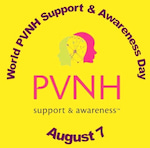World PVNH Disorder Awareness Day Date in the current year: August 7, 2026
 World PVNH Disorder Awareness Day, also known as World PVNH Day, is observed annually on August 7. It was created to raise awareness of periventricular nodular heterotopia, a brain malformation that typically causes seizures.
World PVNH Disorder Awareness Day, also known as World PVNH Day, is observed annually on August 7. It was created to raise awareness of periventricular nodular heterotopia, a brain malformation that typically causes seizures.Periventricular nodular heterotopia is a type of gray matter heterotopia, a neurological disorder caused by gray matter located in an atypical location in the brain. During the development of the fetus, neurons form in the outer layer of the gastrula (a stage of embryonic development) and then travel through the previous layers to reach their proper destination. Gray matter hetreotopia occurs when they fail to reach their destination and end up elsewhere in the brain.
In people with periventricular nodular heterotopia, neurons form clumps (nodules) around the ventricles, four interconnected cavities in the brain filled with cerebrospinal fluid. These nodules can be small or large, simple or multiple. The disorder is usually caused by a genetic mutation (acquired or inherited); women are affected more often than men. PVNH can also be associated with other cortical malformations and other disorders such as Ehlers-Danlos syndrome.
Up to 90% of people with PVNH develop epilepsy that can be drug-resistant, i.e. fail to respond to seizure medications. The seizures usually first appear around the onset of puberty. The type of seizures and their severity depends on the location and size of neuron clumps and the involved region of the brain. In some cases, the disorder also results in mild intellectual disability. Some patients may struggle with mobility issues or dyslexia.
The treatment of PVNH is focused on controlling seizures. There are several treatment options, and the best treatment course is determined for each patient individually. These options include anti-seizure medications, epilepsy surgery (including minimally invasive procedures), dietary therapies, and neurostimulation devices. It should be noted that while these treatments may provide full or partial relief from seizures, they do not reverse intellectual disability.
The prognosis for patients with PVNH varies depending on the severity of the condition. Some people can lead normal lives as long as they take anti-seizure medications, while others can struggle even with treatment. The good news is, the disease does not tend to progress once symptoms occur.
World PVNH Disorder Awareness Day was created in 2012 by Yolaine Dupond from Canada. She chose the date of August 7 to commemorate the birthday of her daughter Ella who passed away at age 3 die to complications of two rare conditions, PVNH and Ehlers-Danlos syndrome.
You can get involved with World PVNH Disorder Awareness Day by learning more about PVNH or sharing your experiences with the disorder (of course, only if you’re comfortable doing it), wearing pink and yellow to raise awareness and start conversations, donating to an organization that funds research into PVNH or supports PVNH patients and their families, and spreading the word on social media with the hashtags #WorldPVNHDay, #PVNHDay and #PinkAndYellow.
- Category
- International Observances
- Tags
- World PVNH Disorder Awareness Day, World PVNH Day, international observances, awareness days, periventricular nodular heterotopia